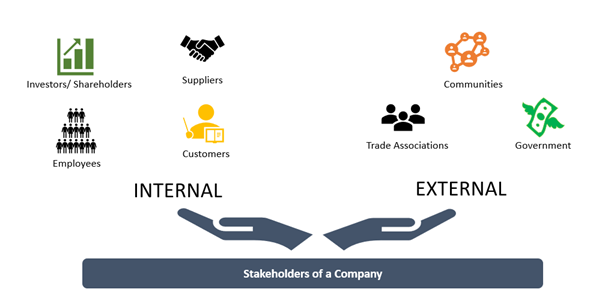Who are the stakeholders?
Stakeholders of an enterprise or firm are individuals that have an interest in the entity. They may not have ownership interest but other interests. Stakeholders can include debtors, creditors, owners, customers, suppliers etc.
Even though corporations are profit-making organisations, but due to increasing bent towards corporate social responsibilities, the organizations are contributing to a non-profit or social cause. On this basis, it has been contested stakeholders should consist of wider elements from the business environment, including nature, societies, communities and so on.
In the making of a business, there are several people involved directly or indirectly, and every person is a stakeholder. Stakeholders help the organisation in some ways and are impacted by the decisions undertaken by the firm.
Some examples of Internal and External stakeholders of a company

Source: Kalkine Media
External vs Internal Stakeholders
Internal stakeholders are those people who have a direct interest in the company and are impacted directly by the decisions of the firm. The decision of the company indirectly impacts external stakeholders.
Investors, Suppliers, and employees are the internal stakeholders of the business. If a business is operating successfully, it would be beneficial for the investors and employees of the company.
Communities, creditors, and tax authorities are external stakeholders of the business. For example, a change announced by the Government in the accounting system of manufacturing units would affect the business operations of an entity.
Shareholders vs Stakeholders
Shareholders are the owners of the business and have a part in the losses and profits of the business. They also have a right to vote on the crucial decisions of the firm like the appointment of Board directors or CEO. They have a financial interest in the company. Shareholders are part of a bigger bracket called Stakeholders.
Stakeholders don’t usually have ownership in the firm but have a vested interest in the company. They would not have the right to vote on the decisions of the company. For example, a supplier of the firm has an interest in the firm.
Types of Stakeholders
Customers
A customer is a stakeholder because they use the products and services of the company. Any change to the products and services would impact the customers. For example, if a company is not performing good, the vendors in its supply chain may feel the heat as production may be reduced and the company may also no longer uses its service.
Communities
They are one of the most important external stakeholders of the company. Communities are impacted by economic activity, job creation and infrastructure development by the firm. Some companies attempt to give back to communities through charities and donations.
Governments
Governments are also important stakeholders for the business. Companies pay taxes to Governments, and tax could be direct or indirect. Companies are a source of revenue for Governments and help Governments to improve economic conditions.
Employees
Employees are internal stakeholders of the company and contribute towards the growth of the company. The company pays the wages in return for the services provided to the company. Any change in the company policies or performance directly flows to the employees.
Investors
Investors or owners of the business are internal stakeholders of the company. They have voting rights on the decisions of the company and have a share of profits or losses generated by the firm. Investors look for the return on the capital invested in the business.
 Please wait processing your request...
Please wait processing your request...